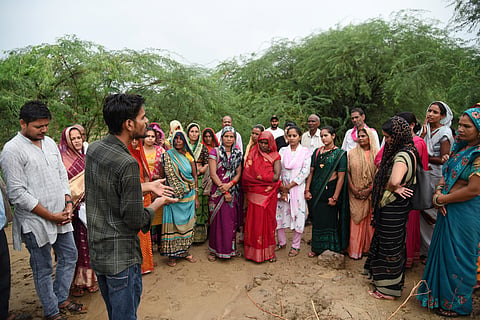
- Topics
- Feature
- Opportunities & Events
- About
- Hindi Portal
- Data
- Topics
- Feature
- Opportunities & Events
- About
- Hindi Portal
- Data

Mamta Patel, a local farmer of Onta Purwa village in Chhatarpur, Madhya Pradesh, reported that the irregular monsoon has posed significant challenges for the kharif season. Farmers in the village are grappling with the adverse effects of erratic rainfall on their groundnut cultivation.
"All of us (farmers) sowed groundnuts after the initial monsoon rains, but since then, there has been no rainfall. This has made farming very difficult this season," she explained.
She highlighted water scarcity in the village, where the demand far exceeds the supply. "Most of our farming relies on rainfed irrigation, and we are supplementing this with pumped groundwater. However, this practice is further depleting the groundwater levels. The recharge is much lower compared to the extraction," she added.
Another villager from nearby Kadamawa gram panchayat shared the hardships villagers face due to water scarcity. "We have to travel 1.5 kilometres to fetch water, which presents significant challenges and consequences in our daily lives," she said.
This situation is not unique. Many villages across the region face similar issues. There are media reports that youth find it difficult to get brides and that women's vulnerability is exacerbated by having to stand in queues for water from the region.
To aid in the development of water stewardship at community level and the sustainable use and management of groundwater amidst escalating water stress, the Government of India launched the Atal Bhujal Yojana (ABY) in 2019. This flagship scheme targets seven states, including 11 districts in the Bundelkhand region. The program's key component involves formulating and implementing a community-led water security plan at the panchayat level by assessing the groundwater balance specific to each panchayat.
However, after five years of implementing the first phase, on-field observations indicate that the capacity building efforts under the program need further strengthening with innovative approaches and new techniques that can enable effective grassroots implementation.
Archisman Mitra, researcher at the International Water Management Institute (IWMI), said that the sustainability of the water user groups created under ABY beyond the program will crucially depend on how effectively the training programs can foster local leadership. This leadership needs to actively participate in various ABY activities and mobilise the water user group and the larger community in water management and planning.
“Most successful case studies of participatory groundwater management also highlight the role that local leaders have played in their success. Atal Bhujal Yojana needs to build capacity for local leadership by tapping into existing institutions like women's self help groups under the National Rural Livelihoods Mission (NRLM), elected leaders of panchayats, community health workers, etc., to ensure that the participatory groundwater management efforts under the program are sustained,” he said.
Currently, IWMI, in collaboration with the National Project Management Unit (NPMU) and State Project Management Units (SPMU) of ABY, is piloting a module to build leadership at the gram panchayat level as part of CGIAR Initiative on National Policies and Strategies. IWMI has partnered with Professional Assistance for Development Action (PRADAN) in Madhya Pradesh and Centre for microFinance (CmF) in Rajasthan, piloting the module in seven districts in both states.
“The idea is to supplement the existing training and capacity-building processes of the ABY program by focussing on the 'community leadership' component. The module aims to stimulate and trigger both individual and collective actions towards making the village water sufficient,” Kumar Ranjan Parhi of CmF explained.
The training module focused on creating leadership for water management at the village level and included a one-day exposure visit to observe modern irrigation systems, farm ponds, check dams constructed under ABY, and community-led rejuvenation of water bodies. Shaheb Singh Chandel, an ABY volunteer from Bariyarpur Bhumiyan in Panna district, noted that local leadership for active community involvement could significantly impact the success of the yojana. “The community leadership aspect was new to us, and the exposure visits provided a real picture of community-led changes. I hope this training will help us achieve water security at the village level,” he said.
The authors work with International Water Management Institute in India and acknowledge support provided by Dr Alok Sikka, Country Representative, IWMI India to carry out this work.